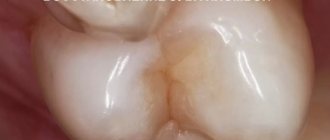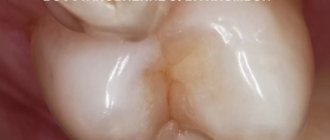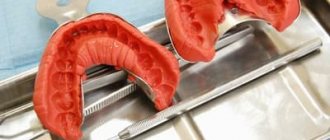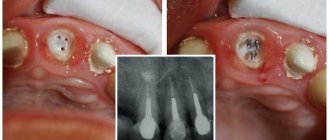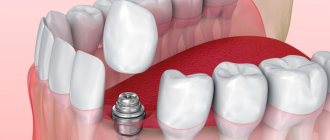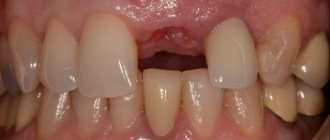January 12, 2018
If the crown or top of the tooth is too badly damaged and it is impossible to fix an artificial crown on it, some kind of support must be installed - this can be a metal pin or a stump inlay. Both of these prostheses are designed to strengthen the tooth root and create support for the crown, since part of them is located above the gum. But they have quite a lot of differences. UltraSmile.ru decided to figure out which of these prostheses is better for restoring a tooth.
Content
- Details about the pin
- Details about the tab
- Materials for production
- What the inlay and pin have in common
- Differences
- What to choose - pin or tab
Currently, dentists offer many options for prosthetics and dental treatment. Modern technologies can solve almost any problem. It is important to choose the best option for a particular case. If treatment of a decayed tooth is required, the choice is between an inlay and a pin.
PROMOTION
Dental restoration, installation of fillings
from 2200 rub.
Pros and cons of tabs
To decide which is better, a pin or an inlay, you need to evaluate the strengths and weaknesses of both types of designs. The advantages of tabs are:
- They can withstand high chewing loads and are securely fixed in the root canals.
- Easily replaceable in case of destruction.
- They allow you to restore teeth with curved and even impassable canals.
- Durability and structural strength.
- Possibility to serve as a support for fixed prosthetics (bridge).
Flaws:
- Long production time.
- Careful preparation of dental tissues and significant grinding.
- Long-term treatment: several visits to the dentist will be required.
Pin
This is a rod installed in the root of the tooth to strengthen it and ensure subsequent treatment. It is installed when there is severe destruction, when no more than half of the root remains. The materials used for manufacturing are polymers or metals. A serious disadvantage of metal pins is the need to greatly expand the root canal, as a result of which its strength decreases. Fiberglass pins do not have this drawback and are similar in characteristics to natural dentin.
When choosing a manufacturing material, we proceed from specific requirements:
- For prosthetics of the front teeth, fiberglass is used;
- Metal products are intended for chewing units with severe destruction;
- Carbon fiber is a universal option, suitable for any teeth.
There are two types of fastening:
- Passive – on dental cement, without load on the root;
- Active - the pin is screwed into the root using a thread.
Comparative characteristics of the standard pin and stump
In order to figure out which type of prosthetics is the best, we will analyze the positive and negative aspects of using both designs. Positive aspects of using standard pins :
- They involve a more gentle preparation of the tooth cavity.
- They have low cost.
- Allows you to perform treatment in one session.
Negative aspects of using pins:
- There is no chemical connection between the intra-root and coronal parts, so they can easily separate.
- If there is no supporting platform or the pin does not fit well on it, under heavy loads the rod can deform the root and lead to necrosis of adjacent tissues.
- When the pin is screwed in, a wedging effect occurs, damaging bone tissue.
Positive properties of using a stump tab:
- Since the pin and stump are cast from a single durable material (most often cobalt-chrome, gold-containing alloys or zirconium oxide), their separation is impossible, which makes the structure extremely durable.
- There are virtually no wedging loads; the pressure during chewing is transmitted not only to the pin and root, but also passes along the axis of the root due to the larger contact area between the inlay and the cross-section surface of the root.
- When cementing the inlay, there is virtually no pressure on the tooth root.
Negative aspects of using a stump pin insert:
- It is not possible to make a prosthesis in 1 session - 2 visits to the clinic are required (since the prosthesis is made in a laboratory).
- More extensive preparation of the tooth for a crown, since it is necessary to thoroughly clean its interior. But at the same time, the doctor will also remove all pathogens that could be in the tissues and contribute to the process of tooth decay.
- Higher cost.
Thus, we can conclude that stump pin inlays are a more reliable, durable and aesthetic method for installing prostheses. In the case of dental prosthetics using core inlays, the service life of the structures increases several times than when restored using anchor pins. A tooth pin is used mainly in cases where it is possible to restore a tooth without using a crown. The existing shortcomings are not so important if you turn to professionals. As for the cost, having installed such a prosthesis once, you will still pay less than with regular correction of standard pins. Although, of course, you need to consult a doctor. There are a number of cases where dental prosthetics using pin structures is indicated. A qualified specialist will explain all the nuances to you and select the right option.
You can sign up for free
consultation at our clinic. Call tel..
The doctors at our clinic have many years of experience restoring teeth using the above structures.
Tab
This is also a prosthetic design that imitates part of a tooth. Used for teeth located behind the canine teeth.
There are:
- Restorative inlays - to recreate the correct shape, bite and natural shade of the tooth;
- Stump inlays are placed under the crown and serve as the foundation for it.
The difference from the pin is in the device - the inlays consist of two parts - the pin itself and an element that replicates the tooth. The manufacturing process takes place under pressure at high temperatures. The root part is an attachment for the root and looks like a rod. The upper element follows the shape of a crown.
The difference between a pin and an inlay during tooth restoration
What is the difference between a pin and an inlay?
Only a doctor can make the right choice, guided by the degree of tooth destruction and the possibility of using one of these types of restoration. Both methods have their advantages and disadvantages; only an experienced dentist at Dr. Grossmann German Dentistry has all the necessary information to make the right choice.
Advantages of pins in tooth restoration.
If we are talking about restoring a tooth using a pin, then strong cleaning of the tooth is not required, since the pin is much thinner than the inlay, which ensures its popularity in dental practice. Also, the cost of treatment using a pin is usually lower than using an inlay. In addition, this technique reduces treatment time down to 1 visit to the dentist’s office. This method is most popular among patients.
Disadvantages of dental restoration using pins.
When treating a tooth using a pin, there is no connection between it and the tooth crown itself, therefore, under heavy chewing loads, the crown may fall off; Also, if the material from which the pin is made is incorrectly selected, the tooth may place excessive load on the jaw bone, which will lead to deformation of the tooth root and its destruction. This can lead to inflammation at the root. To avoid such troubles, it is necessary to perform dental treatment only in elite dentistry, where doctors have the necessary experience, knowledge and use only high-quality materials. German dentistry of Dr. Grossmann meets all the requirements of high-quality elite dentistry in Moscow.
Benefits of restoring teeth using inlays.
The inlay is a one-piece structure that consists of the roots and the crown itself, so the service life of such an artificial tooth increases. In addition, very durable metal alloys are used in the manufacture of the inlay, which makes the restoration the most reliable. The load during chewing is distributed evenly on the bone along the tooth shaft, as well as the root and crown of the tooth, which allows you not to overload the jaw bone tissue and increase the service life of the inlay.
Disadvantages of tabs.
As a rule, such dental treatment does not occur in one visit to the dentist; prosthetics can last two or three sessions; the fact is that the dental inlay is made in a dental laboratory using individual impressions. Also, to install such a structure, more tooth preparation is required, and this is not possible in every case, but still, this is an excellent alternative to installing an implant if the patient has preserved the root of the tooth. Of course, if we are talking about the differences between a pin and an inlay, it is necessary to take into account all the features of such a restoration, as well as the duration of the procedure. The price of prosthetics using an inlay is usually more expensive, but despite its disadvantages, this technique is the most reliable and durable.
Material of manufacture
A variety of materials can be used, including:
- Metals and composites are the most popular option, they are easy to manufacture, durable and have an affordable price;
- Ceramic - similar to natural tooth enamel, the most aesthetic option;
- Zirconium - combines the best qualities of the previous options - they are aesthetically pleasing and durable, but are not very popular because they are very expensive.
Pin Features
The pin is a structure shaped like a rod. It is designed to strengthen a damaged tooth. It is usually fixed in the root canal of the tooth.
It is also possible to install a pin in cases where there is severe tooth loss, and the only solution for restoration is to build it onto a pin.
Modern dental clinics can offer many different types of post structures.
Varieties
Depending on the material used, products are classified into:
- Standard. They can be presented in the form of a cylindrical or conical shape. These types of pins are used when there is slight destruction of the dental unit. A special tool is used to adjust the rod to the root tissue.
- Metal. Their use is advisable in cases of severe damage. The pin, made of titanium, helps to effectively strengthen the part that has undergone restoration.
- Fiberglass. This material is characterized by increased elasticity and is not able to react with the prosthesis and human saliva. In addition, fiberglass is invisible through a crown or filling. Rods made from this material are very popular and have recently replaced the metal pin.
- Individual. The product is manufactured taking into account the relief of a particular root. Such pins are characterized by increased reliability compared to standard ones, since they are able to hold a tooth even in a weak root canal.
- Carbon fiber. This is a more modern version of the pin design. They are stronger and are able to evenly distribute the chewing load inside the root.
- Anchor. A titanium alloy is used to make such a rod. Today this is one of the popular and more effective methods of restoring lost units.
Pin-stump inlay
Among the main objectives of dentistry is the preservation and restoration of teeth, regardless of the degree of their destruction.
According to the shape of the root system channel, the pins are divided into:
- screw;
- conical;
- cylindrical;
- cylindrical.
The pin can be fixed in two ways:
- active;
- passive.
In the first case, the rod is attached to the dentin. This type of fastening is considered the most reliable. The pin has a thread with which it is screwed into the bone tissue.
This method is used when restoration of an almost completely destroyed dental unit is required. However, it is worth mentioning that the active pin can create increased tension, resulting in an increased risk of tooth fracture.
The longer a decayed tooth remains unloaded, the greater the likelihood that atrophy of the bone tissue underneath will occur.
In this case, restoration of the jaw tissue may be required before performing dental procedures. More often, artificial gum or bone augmentation is performed.
Dentist
Novikova Olga Alexandrovna
8 years of experience
When using a passive type of product, fixation is carried out using a special dental composition. The method is advisable for the purpose of strengthening the unit after treatment.
When can a pin be placed?
The pin design is indicated in the following situations:
- the crown part of the tooth has more than 50 percent of the destroyed surface;
- the dental crown is completely missing;
- you need to create a support for a removable or non-removable product.
Fiberglass pins
To restore a tooth, most of which has been destroyed, a fiberglass pin is used in dentistry.
It is not recommended to install pins if there are:
- diseases ;
- damage ;
- inflammatory processes;
- carious lesions;
- cyst or granuloma of the oral cavity;
- pathologies of the central nervous system.
In addition, inappropriate root length relative to the height of the coronal part and if the thickness of the root wall is less than two millimeters are considered contraindications.
What you need to know
The type of construction is selected based on the client’s financial capabilities and wishes, as well as the degree of destruction. In any case, when choosing one type of pin or another, you must listen to the opinion of a specialist.
Why can our articles be trusted?
We make health information clear, accessible and relevant.
- All articles are checked by practicing doctors.
- We take scientific literature and the latest research as a basis.
- We publish detailed articles that answer all questions.
When choosing a suitable design, it is important to take into account the following points:
- How badly is destroyed , as well as how thick its walls are.
- At what level relative to the gingival tissue did the damage occur?
- load distribution on the tooth. Is it a support for a prosthesis or stands alone?
The choice of material used should also be treated with special attention. It is important to take into account the general health of the patient and the ability to take the necessary actions after treatment.
Differences
- The pin puts pressure on the root of the tooth, which can cause it to become loose; there is pressure on adjacent teeth, and the inlay eliminates this load.
- Time of use - the pin can be used for up to 3 years, the inlay - much longer, almost 10 years.
- The pin is a single design, but the tab can separate.
- It is not difficult to make a pin, but to make an inlay, laboratory specialists are involved and special studies are carried out.
- The installation of the pin is carried out in one visit to the dentist; to install the inlay, you will have to visit the doctor at least twice.
- If the tooth has a crooked root, you can only use an inlay.
- The cost of an inlay is significantly higher than a pin.
- Preparing the tooth for the installation of a pin is relatively gentle; in order to install the inlay, a large amount of tissue is removed.
What to choose?
Judging by the above data, both types of structures have their positive and negative qualities. So, what is better, a pin or an inlay, and what should you choose? There is no clear answer to this question, since the choice will depend on the clinical situation, the degree of tooth decay and possible indications. It is best to immediately contact an orthopedic dentist for consultation, who will accurately determine whether it is possible to install a pin structure with subsequent restoration of the coronal part or whether a stump inlay will be required immediately.
Types of stump inlays
Before installing a core inlay, it is imperative to treat the damaged tooth, remove all tissue damaged by caries, and also be sure to properly process and seal the root canals.
IMPORTANT: Root canal treatment is a process in which not the slightest mistake should be made! If the canals are treated poorly or improperly sealed, an inflammatory process may begin in them. In our dental clinic in Moscow - Firadent - treatment of tooth canals is carried out under a microscope, which allows the doctor to see the length and structural features of the canals and thus eliminate errors in the process of their treatment.
After treating the canals of the tooth, the orthopedic dentist begins to treat the patient: the specialist will unseal the canals to the length of the future stump inlay and take an impression for its manufacture. As we already wrote above, core inlays are produced in a dental laboratory.
There are several types of stump inlays. The classification of inlays is carried out according to the material of manufacture and the number of pins - fastenings with which the inlay will be firmly held in the tooth canals. The inlay may have several pins, their number is determined by the number of canals of the tooth being restored.
Based on the number of pins, the following types of stump inlays are distinguished:
- Single-rooted;
- Double-root collapsible and non-removable tabs;
- Three-root collapsible and non-removable stump inlays.
Multi-root inlays are most often made collapsible - this simplifies the process of securing the inlay in the tooth canals. But collapsible inlays are more expensive than non-demountable structures: the higher price is explained by the high complexity of manufacturing.
